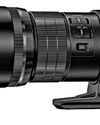
One way to deal with a high-contrast situation is to use a Graduated Neutral Density (GND) filter. GND filters are are also known as Split Neutral Density filters. The lower half of a GND filter is totally transparent while the upper half has a gradual darkening. Using a filter holder (you could also use the filter without the holder) you adjust the filter in front of the lens so that the demarcation line is at or near the horizon. GND filters are available in various strengths. Meter the sky and the foreground, while keeping the aperture and ISO unchanged. Let us assume that the difference in shutter speed is four stops. In other words, the sky is four stops brighter than the foreground. In such a situation you should opt for a three-stop GND filter (if you use a four stop GND filter, the sky as well as the foreground would be at a same brightness level, which would look wrong; you want the sky to be brighter). While this method is workable, there can be issues if the horizon in the scene is not level or if there is some projection into the sky (trees or buildings for example). The projected area would also get darkened gradually.
A better solution is to use two, three, five or even exposures of the same scene with varying exposures and then combining them in a specially designed software.
Note: It is possible to create an HDR effect using a single raw capture. This is often known as Pseudo HDR (False HDR). The final result will be good but not as good as an HDR photo created using two or more captures.
How do you expose the images for an HDR effect?
There are several ways to do this. For all the methods, I suggest that you shoot in Raw format.
This story is from the {{IssueName}} edition of {{MagazineName}}.
Start your 7-day Magzter GOLD free trial to access thousands of curated premium stories, and 9,000+ magazines and newspapers.
Already a subscriber ? Sign In
This story is from the {{IssueName}} edition of {{MagazineName}}.
Start your 7-day Magzter GOLD free trial to access thousands of curated premium stories, and 9,000+ magazines and newspapers.
Already a subscriber? Sign In

SELECTING THE RIGHT SYSTEM
Buying a new mirrorless camera can be a daunting decision. Not only are cameras very expensive, but also choosing a brand with an exclusive mount can mean locking yourself into a system.

Capturing Momenta Folding Boundaries
With the Pixel 9 Pro Fold, Google takes cues from its impressive line-up of Pixel smartphones and resolves some of the design oddities we’ve seen on foldable smartphones from more seasoned competitors in the category.

Super Sharp
Smart Photography reviewed the OM System OM 1 Mark II camera last month. If you haven’t read the review, please do so.

HIDDEN FEATURES OF YOUR CAMERA
Ashok Kandimalla has been in the photographic field for over three decades and has extensive experience in both film and digital photography.

Hahnemühle Hemp Paper at Olympics & Paralympics 2024
As the 2024 Paris Olympics and Paralympics embraced sustainability, Hahnemühle’s Digital FineArt Hemp paper played a central role as the exclusive medium for the official Premium Posters. This eco-friendly, plant-based paper aligned with the Games’ commitment to sustainability and delivered exceptional print quality. From limited-edition posters to the Artistic Posters Programme, Hahnemühle’s innovative use of hemp fibres showcased how high-value print products continue to thrive in a rapidly digitizing world.

The Lasting Power of Print: Preserving Memories Through Photobooks
I am a software engineer turned photographer, and my journey in photography has been a constant companion throughout my life.

The Wildlife of Eastern Mongolian Steppe
Mohit Ghatak is an engineer and a management postgraduate and works as a regional business leader in Singapore.

Abhishek Dey's Photo World
I identify myself more as a travel photographer than a purely landscape photographer.

Manfrotto lithium ion batteries for cameras
Manfrotto has introduced its new MKII lithium-ion batteries, featuring a higher capacity of 2400mAh for Nikon, Sony, Canon, Fuji, and OM System cameras.

Canon to have EOS C80 with enhanced features
Canon announced the launch of its latest Cinema EOS camera, the EOS C80, just ahead of the International Broadcasting Convention (IBC) 2024.